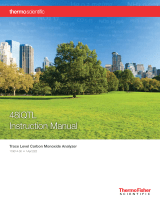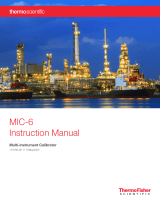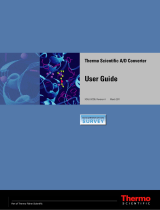Page is loading ...

Part of Thermo Fisher Scientific
Sarasota SG901
Specific Gravity Analyzer
User Guide
P/N HB-SG901
Revision E


Sarasota SG901
Specific Gravity Analyzer
User Guide
P/N HB-SG901
Revision E


© 2012 Thermo Fisher Scientific Inc. All rights reserved.
“Ni-Span C” is a registered trademark of the Special Metals Corporation.
“HART” is a registered trademark of the HART Communication Foundation.
All other trademarks are the property of Thermo Fisher Scientific Inc. and its subsidiaries.
Thermo Fisher Scientific (Thermo Fisher) makes every effort to ensure the accuracy and completeness of this
manual. However, we cannot be responsible for errors, omissions, or any loss of data as the result of errors or
omissions. Thermo Fisher reserves the right to make changes to the manual or improvements to the product at
any time without notice.
The material in the manual is proprietary and cannot be reproduced in any form without expressed written
consent from Thermo Fisher.

This page intentionally left blank.

Thermo Fisher Scientific Sarasota SG901 User Guide v
Revision History
Revision Level Date Comments
A 03-2009 Initial release (ECO 6849).
B 06-2010 Revised per ECO 7413.
C 08-2010 Revised per ECO 7494.
D 01-2011 Revised per ECO 7628.
E 01-2012 Revised per ECO 7874.

This page intentionally left blank.

Thermo Fisher Scientific Sarasota SG901 User Guide vii
Contents
Explanation of Symbols ..................................................................................... ix
Warnings .............................................................................................................. xi
Control of Substances Hazardous to Health ........................................... xi
Electrical Safety ...................................................................................... xi
Product Overview ............................................................................................. 1-1
Introduction ........................................................................................ 1-1
Configurations ................................................................................. 1-1
Basic System .................................................................................. 1-2
Dry Gas System ............................................................................ 1-2
Wet Gas System ............................................................................ 1-2
Operation ........................................................................................... 1-2
Installation ......................................................................................................... 2-1
Mechanical Considerations ................................................................. 2-1
Cabinet Support Structure ............................................................... 2-1
Weatherproof Cabinet ...................................................................... 2-1
Pipelines/Sample Tubing ................................................................. 2-1
Safety ............................................................................................... 2-2
Electrical Considerations ..................................................................... 2-2
Cable Specification ........................................................................... 2-2
Safe Areas ......................................................................................... 2-2
Hazardous Areas ............................................................................... 2-2
Electrical Installation ........................................................................... 2-3
Protective Earth Grounding ............................................................. 2-3
Safety Disconnecting Means Requirements ...................................... 2-3
Frequency Output Option ............................................................... 2-4
Headmount Option ......................................................................... 2-4
Electric Heater ................................................................................. 2-4
Commissioning .................................................................................................. 3-1
General ............................................................................................... 3-1
Initial Power Up ................................................................................. 3-1
Frequency Output Option ............................................................... 3-1
Headmount Option ......................................................................... 3-1
Sample System ................................................................................. 3-2
Density Converter ............................................................................ 3-2
Chapter 1
Chapter 2
Chapter 3

Contents
viii Sarasota SG901 User Guide Thermo Fisher Scientific
Validation ............................................................................................................ 4-1
General ............................................................................................... 4-1
Validation with an Injection Sample ................................................... 4-2
Validation with a Process Gas Sample ................................................. 4-3
Calibration .......................................................................................................... 5-1
Field Adjustments ............................................................................... 5-1
SG Definition & Calculation .............................................................. 5-1
Adjustment ......................................................................................... 5-2
Correction Calculation ..................................................................... 5-2
Maintenance ...................................................................................................... 6-1
Preventive Maintenance ...................................................................... 6-1
Thermometry Check ........................................................................ 6-2
Electric Heater Check ...................................................................... 6-2
Pressure Transmitter Check ............................................................. 6-2
Filter Condition ............................................................................... 6-3
Density Sensor Check ...................................................................... 6-3
Troubleshooting & Service ............................................................................. 7-1
Fault Diagnosis ................................................................................... 7-1
Troubleshooting Sarasota SG901 / CM515 Density Systems .............. 7-2
Contact Information ........................................................................... 7-5
Warranty ............................................................................................. 7-6
Ordering Information ....................................................................................... A-1
Specifications ................................................................................................... B-1
Drawings ............................................................................................................ C-1
Health & Safety Clearance Form ................................................................... D-1
Equations............................................................................................................ E-1
Configuration Considerations when Using Sarasota CM515 ................... F-1
Purpose ............................................................................................... F-1
Equations ............................................................................................ F-1
Critical Temperature and Critical Pressure .......................................... F-3
General Configuration (Metric) for SG Measurement ......................... F-5
Index .......................................................................................................... INDEX-1
Chapter 4
Chapter 5
Chapter 6
Chapter 7
Appendix A
Appendix B
Appendix C
Appendix D
Appendix E
Appendix F

Thermo Fisher Scientific Sarasota SG901 User Guide ix
Explanation of Symbols
The following symbols are used in this guide or on the equipment:
Caution: Risk of danger. Refer to user guide.
Warning: Electrical shock hazard.
Warning: Hot surface hazard.
Protective ground

This page intentionally left blank.

Thermo Fisher Scientific Sarasota SG901 User Guide xi
Warnings
Know the safety precautions and first aid instructions before you use a
hazardous substance.
Read the label on the container in which the substance is supplied.
Read the data sheet applicable to the substance.
Obey the local orders and instructions.
Warning Remove all power from the unit before making any connections.
Electrocution can result if power is present.
Warning Ensure the power supply is isolated. Take suitable precautions to
prevent reinstatement of power while working on the system.
Caution The equipment can be impaired if equipment is not used in a
manner specified by the manufacturer.
Control of
Substances
Hazardous to
Health
Electrical Safet
y

This page intentionally left blank.

Thermo Fisher Scientific Sarasota SG901 User Guide 1-1
Chapter 1
Product Overview
Thermo Fisher Scientific’s Sarasota SG901 specific gravity analyzer is
recommended in applications where specific gravity (SG), molecular weight
(MW), or density at reference conditions (D@ref) can be used in the plant
instead of density at-line conditions. In applications where the process gas
is too dirty, too hot, or at too high a pressure, the Sarasota SG901 allows
for pre-conditioning of the process stream so a measurement can be made.
Typical applications include:
Energy determination
Blending control
Standard volume control
Fuel gas monitoring
Process efficiency
SG for density determination at other parts of the process
The Sarasota SG901 is available in three standard configurations, or
systems, which may be selected based on the condition of the sample
stream. They are the basic system, the wet gas system, and the dry gas
system.
Note that all three systems may have a steam or electric heater mounted
within the enclosure so that the sample gas can be maintained above its
dew point. They are also available with the frequency output or headmount
option (see “Operation” for more on these options).
Introduction
Configurations

Product Overview
Operation
1-2 Sarasota SG901 User Guide Thermo Fisher Scientific
The basic system is ideal for applications in which the sample stream is
already conditioned for other instruments. The analyzer is used in
conjunction with an existing gas conditioning system that provides a clean,
dry sample at a pressure below 4 bar A (58 psi A). This system consists of a
small area dry particle filter, density meter assembly (with integral PT100
temperature element), pressure transmitter, and flow control valve. All
components are interconnected by 1/4-inch (6 mm) stainless steel tubing
and are housed in a weatherproof cabinet.
Refer to drawings SG91-6002 and SG91-6005 in the drawing appendix.
The dry gas system is ideal for applications where the gas is always above its
dew point, but the sample is not filtered and is above 4.5 bar A. It is similar
to the basic system, but it offers a complete package solution to many
applications. The small area dry particle filter is replaced by a larger area
filter capable of handling unfiltered product. An inlet pressure regulator,
safety vent, calibration point, rotameter, and isolation valves are also
included.
Refer to drawing SG91-6001 and SG91-6004 in the drawing appendix.
The wet gas system is similar to the dry gas system, but it allows for the
measurement of gases with significant moisture content. In addition to all
of the dry gas system components, a coalescing filter with auto drain and
isolation valve is fitted. Note that the wet gas system is designed to protect
the system from occasional upsets when condensate may appear in the
stream. If condensate is always in the stream other methods should be used
to ensure the stream is above its dew point.
Refer to drawings SG91-6000 and SG91-6003 in the drawing appendix.
The operation described here is for an instrument fitted with optional
components.
The gas sample passes through a high pressure isolating valve, pressure
regulator, filter assembly, and isolating valve. Both isolating valves are used
during maintenance activities.
Downstream of the isolation valve, immediately before the density meter,
the gas pressure is measured by a precision pressure transmitter. The gas
then flows through the density meter assembly, the rotameter, and the flow
control valve.
A calibration tee, fitted to the inlet pipe of the density meter assembly,
allows for tapping to the calibration valve. The calibration tee facilitates
purging and accurate calibration of the pressure transmitter and SG system.
Basic S
ystem
Dry Gas S
ystem
Wet Gas System
Operation

Product Overview
Operation
Thermo Fisher Scientific Sarasota SG901 User Guide 1-3
With the frequency output option, signal outputs from the transducers are
fed to a Thermo Scientific Sarasota density converter, which calculates the
density (measured), D@ref, SG, and MW of the gas and provides
corresponding 4–20 mA current outputs. All variables and calculated values
can be displayed on the front panel of the converter. Alternatively, with the
headmount version, the Thermo Scientific Sarasota HME900 field
mounted density converter provides a direct HARTcompatible output.

This page intentionally left blank.

Thermo Fisher Scientific Sarasota SG901 User Guide 2-1
Chapter 2
Installation
Note Installation must be carried out in accordance with local site
requirements and regulations.
Refer to the drawings in the drawing appendix for this chapter.
The structure the equipment cabinet will be mounted to shall support four
times the weight of the equipment. Refer to the specification appendix for
unit weight.
The weatherproof cabinet should be mounted securely to a vertical surface
with the process connections at the bottom of the unit. Refer to the
dimensional drawings for mounting dimensions.
The gas inlet should be connected to a suitable tapping on the sample
stream via 1/4-inch bulkhead unions. Inlet piping should be kept as short
as possible to minimize system response time.
The pressure available at the inlet to the Sarasota SG901 system should be
at least 0.4 bar (6 psi) above the control pressure set in the system to ensure
regulation.
Where the ambient temperature can drop below the dew point of the
sample gas, the lines should be insulated or heated.
If the sample stream is at high pressure, a pressure reduction system may be
used to decrease the standard volume in the sample line.
Mechanical
Considerations
Ca
binet Support
Structure
Weatherproof
Cabinet
Pipelines/S
ample
Tubing

Installation
Electrical Considerations
2-2 Sarasota SG901 User Guide Thermo Fisher Scientific
Ideally, the exhaust should be vented at near atmospheric pressure. The
normal method is to exhaust the system to the flare header. If this is not
possible then the system should be exhausted at a pressure of at least 0.4 bar
(6 psi) below the control pressure in the analyzer system.
It may be required to feed the safety vent outlet, where fitted, to a disposal
system or returned to the gas line for environmental reasons.
Note It is the user’s responsibility to ensure that local requirements are
met.
The cable specification for the Sarasota SG901 analyzer is:
BS5308 part 1 : 1986 : type 2
Polyethylene insulated, bedded, single wire armored, PVC sheathed,
five twisted pairs with individual screens, core size 0.5 mm².
This cable is suitable for underground installation.
Maximum distance for transmission of signal is 1 km.
Other cable types may be used, but they must meet requirements for IS
installation.
When the sample gas is non-flammable and the area is non-hazardous,
standard electrical precautions regarding signal cables should be taken in
order to minimize problems associated with electrical noise.
In hazardous areas, appropriate care must be taken to meet local system
requirements and the certification requirements for the Sarasota SG901
analyzer.
Safety
Electrical
Considerations
Cable Specification
Safe Areas
Hazardous Areas
/















